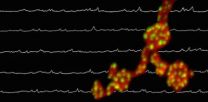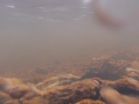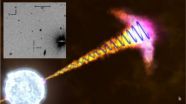(Press-News.org) LA JOLLA, CA—May 7, 2014—Scientists at The Scripps Research Institute (TSRI) have engineered a bacterium whose genetic material includes an added pair of DNA "letters," or bases, not found in nature. The cells of this unique bacterium can replicate the unnatural DNA bases more or less normally, for as long as the molecular building blocks are supplied.
"Life on Earth in all its diversity is encoded by only two pairs of DNA bases, A-T and C-G, and what we've made is an organism that stably contains those two plus a third, unnatural pair of bases," said TSRI Associate Professor Floyd E. Romesberg, who led the research team. "This shows that other solutions to storing information are possible and, of course, takes us closer to an expanded-DNA biology that will have many exciting applications—from new medicines to new kinds of nanotechnology."
The report on the achievement appears May 7, 2014, in an advance online publication of the journal Nature.
Many Challenges
Romesberg and his laboratory have been working since the late 1990s to find pairs of molecules that could serve as new, functional DNA bases—and, in principle, could code for proteins and organisms that have never existed before.
The task hasn't been a simple one. Any functional new pair of DNA bases would have to bind with an affinity comparable to that of the natural nucleoside base-pairs adenine–thymine and cytosine–guanine. Such new bases also would have to line up stably alongside the natural bases in a zipper-like stretch of DNA. They would be required to unzip and re-zip smoothly when worked on by natural polymerase enzymes during DNA replication and transcription into RNA. And somehow these nucleoside interlopers would have to avoid being attacked and removed by natural DNA-repair mechanisms.
Despite these challenges, by 2008 Romesberg and his colleagues had taken a big step towards this goal; in a study published that year, they identified sets of nucleoside molecules that can hook up across a double-strand of DNA almost as snugly as natural base pairs and showed that DNA containing these unnatural base pairs can replicate in the presence of the right enzymes. In a study that came out the following year, the researchers were able to find enzymes that transcribe this semi-synthetic DNA into RNA.
But this work was conducted in the simplified milieu of a test tube. "These unnatural base pairs have worked beautifully in vitro, but the big challenge has been to get them working in the much more complex environment of a living cell," said Denis A. Malyshev, a member of the Romesberg laboratory who was lead author of the new report.
Microalgae Lead to Breakthrough
In the new study, the team synthesized a stretch of circular DNA known as a plasmid and inserted it into cells of the common bacterium E. coli. The plasmid DNA contained natural T-A and C-G base pairs along with the best-performing unnatural base pair Romesberg's laboratory had discovered, two molecules known as d5SICS and dNaM. The goal was to get the E. coli cells to replicate this semi-synthetic DNA as normally as possible.
The greatest hurdle may be reassuring to those who fear the uncontrolled release of a new life form: the molecular building blocks for d5SICS and dNaM are not naturally in cells. Thus, to get the E. coli to replicate the DNA containing these unnatural bases, the researchers had to supply the molecular building blocks artificially, by adding them to the fluid solution outside the cell. Then, to get the building blocks, known as nucleoside triphosphates, into the cells, they had to find special triphosphate transporter molecules that would do the job.
The researchers eventually were able to find a triphosphate transporter, made by a species of microalgae, that was good enough at importing the unnatural triphosphates. "That was a big breakthrough for us—an enabling breakthrough," said Malyshev.
Though the completion of the project took another year, no hurdles that large arose again. The team found, somewhat to their surprise, that the semi-synthetic plasmid replicated with reasonable speed and accuracy, did not greatly hamper the growth of the E. coli cells, and showed no sign of losing its unnatural base pairs to DNA repair mechanisms.
"When we stopped the flow of the unnatural triphosphate building blocks into the cells, the replacement of d5SICS–dNaM with natural base pairs was very nicely correlated with the cell replication itself—there didn't seem to be other factors excising the unnatural base pairs from the DNA," Malyshev said. "An important thing to note is that these two breakthroughs also provide control over the system. Our new bases can only get into the cell if we turn on the 'base transporter' protein. Without this transporter or when new bases are not provided, the cell will revert back to A, T, G, C, and the d5SICS and dNaM will disappear from the genome."
The next step will be to demonstrate the in-cell transcription of the new, expanded-alphabet DNA into the RNA that feeds the protein-making machinery of cells. "In principle, we could encode new proteins made from new, unnatural amino acids—which would give us greater power than ever to tailor protein therapeutics and diagnostics and laboratory reagents to have desired functions," Romesberg said. "Other applications, such as nanomaterials, are also possible."
INFORMATION:
Other contributors to the paper, "A semi-synthetic organism with an expanded genetic alphabet," were Kirandeep Dhami, Thomas Lavergne and Tingjian Chen of TSRI, and Nan Dai, Jeremy M. Foster and Ivan R. Corrêa Jr. of New England Biolabs, Inc.
The research was funded in part by the US National Institutes of Health (GM 060005).
Scientists create first living organism that transmits added letters in DNA 'alphabet'
2014-05-07
ELSE PRESS RELEASES FROM THIS DATE:
Vascular simulation research reveals new mechanism that switches in disease
2014-05-07
BOSTON -- Blood vessel formation is critical to life and its manipulation is instrumental to a number of diseases. For more than 40 years, investigations into the structure and function of endothelial cells lining the blood vessels have revealed a complex tissue with complex functions, demonstrating that endothelial cells participate in all aspects of vascular homeostasis and pathological processes.
Today, important revelations regarding endothelial cell behavior are emerging from vascular simulation research, a blossoming interdisciplinary field that makes use of novel ...
Airborne measurements confirm leaks from oil and gas operations
2014-05-07
During two days of intensive airborne measurements, oil and gas operations in Colorado's Front Range leaked nearly three times as much methane, a greenhouse gas, as predicted based on inventory estimates, and seven times as much benzene, a regulated air toxic. Emissions of other chemicals that contribute to summertime ozone pollution were about twice as high as estimates, according to the new paper, accepted for publication in the American Geophysical Union's Journal of Geophysical Research: Atmospheres.
"These discrepancies are substantial," said lead author Gabrielle ...
Astronomers create first realistic virtual universe
2014-05-07
Move over, Matrix - astronomers have done you one better. They have created the first realistic virtual universe using a computer simulation called "Illustris." Illustris can recreate 13 billion years of cosmic evolution in a cube 350 million light-years on a side with unprecedented resolution.
"Until now, no single simulation was able to reproduce the universe on both large and small scales simultaneously," says lead author Mark Vogelsberger (MIT/Harvard-Smithsonian Center for Astrophysics), who conducted the work in collaboration with researchers at several institutions, ...
Brain noise found to nurture synapses
2014-05-07
NEW YORK, NY (May 7, 2014) — A study has shown that a long-overlooked form of neuron-to-neuron communication called miniature neurotransmission plays an essential role in the development of synapses, the regions where nerve impulses are transmitted and received. The findings, made in fruit flies, raise the possibility that abnormalities in miniature neurotransmission may contribute to neurodevelopmental diseases. The findings, by researchers at Columbia University Medical Center (CUMC), were published today in the online edition of the journal Neuron.
The primary way ...
Native algae species to blame for 'rock snot' blooms in rivers worldwide
2014-05-07
VIDEO:
The recent appearance of the freshwater algae known as "rock snot " on river bottoms worldwide is caused by a native species responding to changing environmental conditions rather than by accidental...
Click here for more information.
The recent blooms of the freshwater algae known as "rock snot" on river bottoms worldwide are caused by a native species responding to changing environmental conditions rather than by accidental introductions by fishermen or the ...
Early depression, anger may taint love life even 20 years later, study shows
2014-05-07
A University of Alberta study is helping crack the code to happiness by exploring the long reach of depression and anger over more than two decades.
The study, published recently in the Journal of Family Psychology, followed 341 people for 25 years, and found that negative emotions they may have suffered as young adults can have a lasting grip on their couple relationships, well into middle age.
The fact that depression and anger experienced during the teen years clung to people, even through major life events such as child-rearing, marriages and careers was surprising, ...
Community doulas can be a big help for mother-baby relationships
2014-05-07
Young mothers are more likely to breastfeed and have positive relationships with their babies when they have another woman "mothering" them in the delivery room, according to new research at the University of Chicago on the value of doulas—women who help with deliveries and early care for mothers and babies.
The assistance from doulas is particularly valuable to young mothers from disadvantaged backgrounds. Those mothers sometimes receive help from women known as community doulas, who are from similar backgrounds as the young women and who visit them weekly for several ...
Emerald ash borers were in US long before first detection
2014-05-07
EAST LANSING, Mich. — New research at Michigan State University shows that the uber-destructive emerald ash borer arrived at least 10 years before it was first identified in North America.
The study, published in the current issue of journal Diversity and Distributions, shows that EABs were feasting on ash trees in southeast Michigan by the early 1990s, well before this pest was discovered in 2002, said Deb McCullough, MSU professor of forest entomology.
"We suspect they arrived inside wood crating or pallets imported from Asia where the beetle is native," she said. ...
Clues about black hole formation
2014-05-07
This news release is available in Spanish.
The work, which has had the participation of the Ikerbasque researcher Javier Gorosabal, co-director of the Associated Unit with the Institute of Astrophysics of Andalusia/CSIC-UPV/EHU, has been published in the prestigious journal Nature.
There is no other event in the cosmos that can compete in terms of energy and intensity with stellar explosions on the outer reaches of the universe and which are known as LGRBs (Long Gamma-Ray Bursts): in just one second a single GRB can emit as many as hundreds of stars like the Sun ...
How businesses can maximize revenue when introducing new products
2014-05-07
BUFFALO, N.Y. — Companies should use existing brand names and add new, sub-brand names to maximize revenue when introducing new products to market, according to a new study from the University at Buffalo School of Management.
Forthcoming in Management Science, the study notes a proliferation of new products in the consumer packaged-goods market each year. For example, U.S. manufacturers introduced more than 150,000 new products in 2010 alone. Of these, more than 90 percent were extensions of existing brand-name products.
"These new products can be line extensions, like ...




